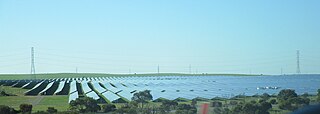
Coleambally is a small town in the Riverina of New South Wales, Australia, in Murrumbidgee Local Government Area.

A solar panel is a device that converts sunlight into electricity by using photovoltaic (PV) cells. PV cells are made of materials that produce excited electrons when exposed to light. The electrons flow through a circuit and produce direct current (DC) electricity, which can be used to power various devices or be stored in batteries. Solar panels are also known as solar cell panels, solar electric panels, or PV modules.

Solar power is a major contributor to electricity supply in Australia. As of December 2023, Australia's over 3.69 million solar PV installations had a combined capacity of 34.2 GW photovoltaic (PV) solar power. In 2019, 59 solar PV projects with a combined capacity of 2,881 MW were either under construction, constructed or due to start construction having reached financial closure. Solar accounted for 12.4% of Australia's total electrical energy production in 2021.

Wind power became a significant energy source within South Australia over the first two decades of the 21st century. In 2015, there was an installed capacity of 1,475 MW, which accounted for 34% of electricity production in the state. This accounted for 35% of Australia's installed wind power capacity. In 2021, there was an installed capacity of 2052.95 MW, which accounted for 42.1% of the electricity production in the state in 2020.

A photovoltaic power station, also known as a solar park, solar farm, or solar power plant, is a large-scale grid-connected photovoltaic power system designed for the supply of merchant power. They are different from most building-mounted and other decentralized solar power because they supply power at the utility level, rather than to a local user or users. Utility-scale solar is sometimes used to describe this type of project.
Kennedy Energy Park is a wind, solar and storage hybrid power station approximately 20 km south east of Hughenden and 290 km southwest of Townsville in Queensland.
The Cestas Solar Park is a 300 megawatt (MW) photovoltaic power station in Cestas, France. Built by Eiffage and Schneider Electric for the developer, Neoen, it opened on December 1, 2015. When it opened on 1 December 2015, Cestas Solar Park was the largest solar photovoltaic power station in Europe. Located in Cestas, to the south of Bordeaux, it spans 260 hectares and produces 300 MWp.
The Hornsdale Wind Farm is an electricity generator in the locality of Hornsdale in the south-west of the Narien Range, north of Jamestown, South Australia. It consists of 99 wind turbines with a generation capacity of 315 megawatts (422,000 hp). The plant is owned and operated by Neoen, a French renewable energy company.
Neoen is a French producer of exclusively renewable energy headquartered in Paris, France. Founded in 2008, it develops, finances, builds and operates solar power plants, onshore wind farms and energy storage solutions. As at 31 December 2023, the company's total capacity was 8 GW, made up of 50% solar, 30% wind and 20% battery storage. Neoen aims to attain 10 GW in operation or under construction by 2025.
The Bungala Solar Power Farm is a 220 MW solar power farm in Emeroo and Wami Kata near Port Augusta in South Australia. The first stage was connected to the grid in May 2018, and the second stage was connected to the grid in November 2018. The project gradually reached full power in 2020.
Hornsdale Power Reserve is a 150 MW grid-connected energy storage system owned by Neoen co-located with the Hornsdale Wind Farm in the Mid North region of South Australia, also owned by Neoen.

The Tailem Bend Solar Power Farm is a solar power farm near Tailem Bend in South Australia. It has 108MW of generation capacity but is limited to supplying 95MW to the national grid. An additional 85MW is proposed in stage 2. It is developed and owned by Singapore-based Vena Energy, a new name for the former Equis Energy following acquisition by Global Infrastructure Partners in January 2018. The output will be sold to Snowy Hydro for retail sale under its Lumo Energy brand. Stage 2 is also expected to provide battery storage.
Darlington Point Solar Farm is a photovoltaic power station, located 10 km south of the town of Darlington Point in New South Wales, Australia, that was launched in 2020. It received planning approval and development consent on 7 December 2018, and has a power purchase agreement for supply of 150MW to Delta Energy. The total output is 333MW DC or 275MW AC. It was commissioned in 2020 and is the largest single solar power station in Australia. The project is owned by Octopus Investments. The contract for engineering, procurement and construction (EPC) is let to a consortium of Signal Energy and Canadian Solar. Canadian Solar also has the operations and maintenance services contract.
Numurkah Solar Farm is a solar photovoltaic power station owned by Neoen near the town of Numurkah in the Australian state of Victoria.
The Metoro Solar Power Station is a 41 megawatts solar power plant in Mozambique. The power station was developed by a consortium comprising Neoen, a French independent power producer (IPP), based in Paris, France and Electricidade de Moçambique (EDM), the Mozambican electricity utility company. Construction began in October 2020, with commercial commissioning expected in the fourth quarter of 2021.
Bangweulu Solar Power Station (BSPS), is a 54 MW (72,000 hp) solar power plant in Zambia. The solar farm that was commercially commissioned in March 2019, was developed and is owned by a consortium comprising Neoen, a French IPP, Industrial Development Corporation of Zambia, a government parastatal company and First Solar, a US-based solar panel manufacturer. The power station cost US$60 million to develop.
Goyder South Wind Farm is the first stage of the Goyder Renewables Zone development near Burra, South Australia. The Goyder South Wind Farm will be on the hills south-east of the town of Burra.






